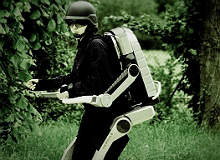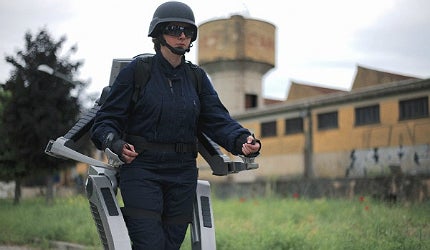

Hercule is the robotic exoskeleton developed by French engineering company RB3D under the steering and funding of the French military procurement agency Direction Générale de l’Armement (DGA). It was developed through the RAPID (Régime d’Appui pour l’Innovation Duale) programme, which funds high-tech innovations with dual military and civilian applications by independent small businesses.
The French word for exoskeleton is ‘exosquellette’, conjuring up a rather more chic image than its international rivals, and it certainly looks the part.
Like Getafix’s potion for Asterix and his friends in the Gaulish village, it imbues exceptional strength – the current version can carry a load of 20kg with each arm, while future versions will be able to withstand 100kg.
According to the DGA, Hercule does not need any special training or skills, the person wearing it just performs his or her usual tasks and the exoskeleton automatically provides additional support and strength as required. However, the engineers involved in Hercule’s development admit it still takes a little practice to get used to.
Hercule – the French HULC
Hercule is electrically powered, unlike some other similar concepts, such as the Raytheon XOS2 that uses a two-stroke internal combustion engines as well as a tethered electrical power source. The life of its Li-On batteries enables the wearer to walk 20km at a moving speed of 4km/h, a regular walking pace, while carrying 100kg.
The battery power enables a near-silent operation, as required by Special Operations and other stealth assignments.
At 25kg it weighs in at a kilogram more than the Lockheed Martin HULC which is being trialled by the US Army, but HULC’s power pack takes up 85lbs of its 200lbs carrying capacity.
It is designated as a collaborative exoskeleton robot, or ‘cobot’, to help the wearer carry heavy loads. Cobots have a heritage of working in a factory environment alongside human workers, for example providing a robotic arm for an operator to carry out difficult tasks on an engineering production line.
Employing a concept known in French as ‘enslavement’, Hercules is not controlled, but supports the efforts of the wearer. For example if they take a step, the mechatronics instantly follow the movement, and keep track of changes in pace or stopping. An inertial system helps keep the balance.
Mechatronics – agile, dextrous and ergonomic
Hercule is mechatronic apparatus, meaning it combines mechanics, computers and electronics, built around a dorsal structure that enables the wearer to easily carry a load. It automatically detects body movements and follows them using low-voltage electric actuators to support the effort being undertaken, rather than the person.
Hercule offers support points at the joints of the feet and legs, with a belt around the waist and ‘braces’ over each shoulder. Each joint is fully animated by electric motors and advanced actuators that offer a higher yield – or movement to effort ratio – than current equivalents, and can also operate in reverse mode.
Related project
Human Universal Load Carrier (HULC), United States of America
The Human Universal Load Carrier (HULC) is an exoskeleton being developed by Lockheed Martin for dismounted soldiers.
The DGA is keen to emphasise the potential for Hercule outside the military. Its agile, dextrous design and ergonomic fit makes it suitable for not just infantry soldiers and Special Forces, but could also support construction workers, aid fire-fighters and transport heavy equipment to disaster relief sites, as well as help medical personnel handle disabled patents.
Intended for use in outdoor environments and a range of extreme climates and even the hilliest terrain, Hercule is designed to withstand dirt, water, dust and the risk of impacts.
Speaking at the Eurosatory defence exhibition in Paris, Vincent Manviseau, a spokesman for the DGA, said: “The current model is a prototype which will be under test for another two years.”
The eventual aim is to make Hercule compatible with FELIN (Fantassin à Équipements et Liaisons Intégrés), the French future infantry soldier system, and it could be fielded as soon as 2014.
Hercule may not have hit the headlines with as much impact as rival US systems, but its practicality, light weight, versatility and ease of use could see it widely embraced not just by the military but by a wide range of civilian applications.



